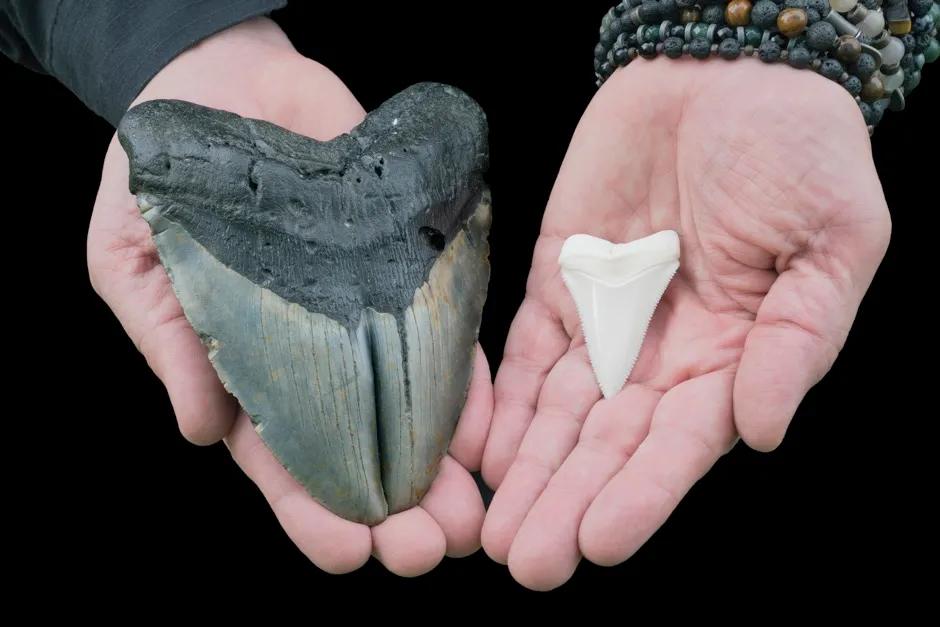The entire size of a prehistoric mega-shark made famous in Hollywood films has been revealed in a new study.
Previously only the length of the megalodon had been estimated, but a team from the University of Bristol and Swansea University have determined the size of the rest of its body including fins as large as an entire adult human.
Read more prehistoric discoveries:
- Mystery solved: 240-million-year-old reptile with 'extraordinarily long neck' lived in the ocean
- Ancient reptile ‘well-preserved’ in stomach of slightly larger reptile
- Ichthyosaur's pebble-like teeth used to 'crush the shells of their prey'
The great white shark – depicted in 1975 movie hit Jaws – is a distant descendant of the megalodon and often measures more than six metres in length.
Researchers used mathematical methods and comparisons with living relatives to find the overall size of the megalodon, which lived from about 23 million to three million years ago but has attracted fame more recently in Hollywood movies including The Meg.
The results suggest a 16-metre megalodon is likely to have had a head around 4.65 metres long, a dorsal fin approximately 1.62 metres tall and a tail around 3.85 metres high.
This means an adult human could stand on the back of the shark and be about the same height as the dorsal fin.

Jack Cooper, who has completed a master of science degree in palaeobiology at the University of Bristol’s School of Earth Sciences, described the study as his “dream project”.
“I have always been mad about sharks. As an undergraduate, I have worked and dived with great whites in South Africa – protected by a steel cage of course,” he said.
“It’s that sense of danger, but also that sharks are such beautiful and well-adapted animals, that makes them so attractive to study."
The study, published in the journal Scientific Reports, was supervised by shark expert Dr Catalina Pimiento of Swansea University and Professor Mike Benton, a palaeontologist at Bristol.
Dr Pimiento said: “Megalodon is not a direct ancestor of the great white but is equally related to other macropredatory sharks such as the makos, salmon shark and porbeagle shark, as well as the great white. We pooled detailed measurements of all five to make predictions about megalodon.”
Read more about sharks:
- Great white shark stomach study shows surprising supper source
- Light shed on secrets of glow-in-the-dark sharks
- Cold War radiation helps scientists to calculate whale sharks' ages
“Megalodon was actually the very animal that inspired me to pursue palaeontology in the first place at just six years old, so I was over the moon to get a chance to study it," said Cooper.
“This was my dream project. But to study the whole animal is difficult considering that all we really have are lots of isolated teeth.”
The researchers first tested whether the modern sharks related to megalodon changed proportion as they grew but found this was not the case.
“This means we could simply take the growth curves of the five modern forms and project the overall shape as they get larger and larger – right up to a body length of 16 metres,” Cooper said.
What is a goblin shark?
Forget the great white shark from Jaws or the megalodon from The Meg: there’s a new superstar shark in town, and it’ll give you more nightmares than both of them combined. Meet the goblin shark.
This secretive, four-metre-long fish was first found off the eastern coast of Japan, where it was described in 1898. With its unusually long snout and fleshy skin tone, the shark was given the name tenguzame – a reference to a mythical Japanese monster with a long face, pink skin and demonic jaws, which led to the Western translation, ‘goblin shark’.
In recent years, rare video footage has shown just how incredible its jaws are. First, the goblin shark uses electroreceptors on its long nose to detect the electrical fields of fish. Then, when prey is located, it uses the natural buoyancy provided by its large, oil-rich liver to float silently towards it. When the unwary fish gets within range – SMASH! – a pair of extendable jaws filled with nail-like teeth lunge out from its face.
In every sense, the goblin shark is a creature ripe for Hollywood to exploit. Let’s just hope that it doesn’t follow in the path of many of its shark cousins and become exploited by fishing fleets, too.
Read more:

